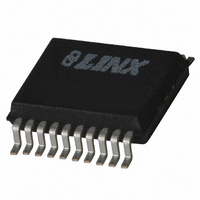LICAL-DEC-HS001 Linx Technologies Inc, LICAL-DEC-HS001 Datasheet - Page 9

LICAL-DEC-HS001
Manufacturer Part Number
LICAL-DEC-HS001
Description
IC DECODER HS SERIES 20-SSOP
Manufacturer
Linx Technologies Inc
Series
HSr
Type
Decoderr
Datasheet
1.LICAL-DEC-HS001.pdf
(11 pages)
Specifications of LICAL-DEC-HS001
Package / Case
20-SSOP
Applications
RF, IR
Mounting Type
Surface Mount
Supply Voltage (max)
5.5 V
Supply Voltage (min)
2 V
Maximum Operating Temperature
+ 125 C
Minimum Operating Temperature
- 40 C
Mounting Style
SMD/SMT
Lead Free Status / RoHS Status
Lead free / RoHS Compliant
Lead Free Status / RoHS Status
Lead free / RoHS Compliant, Lead free / RoHS Compliant
Available stocks
Company
Part Number
Manufacturer
Quantity
Price
Company:
Part Number:
LICAL-DEC-HS001
Manufacturer:
Linx Technologies
Quantity:
135
TYPICAL APPLICATIONS
Figure 8: HS Series Decoder Application Circuit
Page 16
100k
The HS Series is ideal for registering button presses in secure remote control
applications. An example application circuit of the decoder side is shown below.
In this circuit, the baud has been set for 2,400bps by pulling the SEL_BAUD line
to ground.
SEND_COPY, CREATE_KEY, and LEARN are all connected to buttons that will
pull the line high when pressed. Since the lines do not have internal resistors,
100kΩ resistors are used to pull the lines to ground when not in use.
COPY_IN is connected to a port that allows the transfer of the User Data from
another decoder. This port can be a simple wire, an infrared receiver, or any
other device that allows the transmission of asynchronous serial data.
The KEY_OUT line is connected to a port that allows the transfer of the key to
an encoder or another decoder. This port can be a simple wire, an infrared diode,
or any other device that allows the transmission of asynchronous serial data.
The KEY_OUT line can also be connected to a microprocessor or a PC to record
the transmitter identity. Application Note AN-00156 has sample C code that will
read the transmitter ID and display the ID number on an LCD screen.
A LED indicator is attached to the MODE_IND line to provide visual feedback
that an operation is taking place. This line will source a maximum of 25mA, so
the limiting resistor may not be needed, depending on the LED chosen.
The DATA_IN line is connected directly to the data output of the receiver.
Data Lines D0 through D7 can be connected directly to the external circuitry that
is to be activated remotely. In this example, D5 is connected directly to a
piezoelectric buzzer, which will cause the buzzer to sound when the D5 line on
the encoder goes high. Line D6 will activate a relay through a transistor buffer
when it goes high. A buffer like this may be needed if the decoder cannot source
enough current or voltage to energize the relay coil. The decoder will turn on the
transistor, which will provide the appropriate drive levels to the relay.
From Copy Input Port
To Key Output Port
10k
220
100k
2.2k
10
1
2
3
4
5
6
7
8
9
D6
D7
SEL_BAUD
SEND_COPY
GND
GND
COPY_IN
CREATE_KEY
KEY_OUT
MODE_IND
LICAL-DEC-HS001
DATA_IN
LEARN
VCC
VCC
D5
D4
D3
D2
D1
D0
20
19
18
17
16
15
14
13
12
11
100k
From Receiver
TYPICAL SYSTEM SETUP
DESIGN STEPS TO USING THE HS SERIES
Figure 9: Steps to Exchange a Key
1. Create and exchange a key from a decoder to an encoder
2. Establish Control Permissions
Key creation and exchange from a decoder to an encoder
1. Provide a serial data connection from the decoder’s KEY_OUT line to the
2. Provide a serial data connection from the encoder’s DATA_OUT line to the
3. On the decoder, set the LEARN line high and then the CREATE_KEY line high
4. The encoder and decoder will automatically exchange the key using the
The HS Series offers an unmatched combination of features and security, yet is
easy for system designers and end users to operate. To demonstrate this, let’s
take a brief look at a typical user setup followed by more detailed design
information. The Typical Applications sections of the encoder and decoder data
guides show the circuit schematics on which these examples are based.
The high security key is created and exchanged by placing the decoder in the
Create Key Mode. The decoder’s MODE_IND line LED will light to indicate that
the decoder has entered Create Key Mode. The decoder’s CREATE_KEY button
is then pressed ten times to create the key. After the tenth press, the MODE_IND
LED will turn off and the decoder will send the key out of the KEY_OUT line. The
MODE_IND LED on the encoder will light to indicate that the key has been
successfully transferred.
The user establishes what buttons on the encoder will be recognized by pressing
the decoder LEARN button. The decoder’s MODE_IND LED will start flashing
and the user presses the buttons that will be allowed access. Control
Permissions are stored when the LEARN button is pressed again or
automatically after 17 seconds.
There are other powerful options such as programming a user PIN or copying a
decoder but these simple steps are all that is required for a typical setup. It is
really that simple for a manufacturer or end user to setup the product!
encoder’s KEY_IN line. Typically this would be a wire, contact, or infrared.
decoder’s DATA_IN line. Typically, this would be a wireless connection using a
transmitter and receiver combination.
to enter Create Key Mode. Take the LEARN line low, and toggle the
CREATE_KEY line high and low ten times to generate the key.
DATA_OUT / DATA_IN and KEY_OUT / KEY_IN lines. If the key exchange is
successful, the decoder and encoder MODE_IND lines will go high for 1 second.
KEY IN
DATA OUT
1
2
3
4
KEY OUT
CREATE KEY BUTTON
LEARN BUTTON
SEND COPY BUTTON
MODE_IND
DATA IN
Page 17























